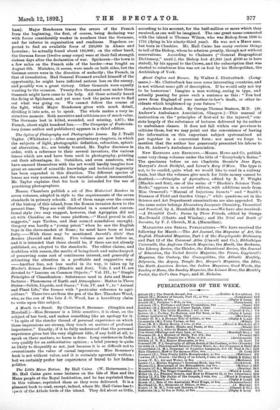lifessrs. Chambers publish a set of New Historical Readers in
seven volumes, adapted in style to the requirements of the seven standards in primary schools. All of them range over the course of the history of this island, from the Roman invasion down to the present time. They are well illustrated in a somewhat conven- tional style (we may suggest, however, that Agrippina did not sit with Claudius on the same platform,—" Hand procul in alio suggestu," says Tacitus, and that seemed scandalous enough). Gregory was hardly a "young priest" when he saw the English boys in the slave-market at Rome ; he must have been at least forty.—With these may be mentioned Jarrold's Girls' Own Readers (Jerrold and Sons). Five volumes are now before us, and it is intended that there should be, if there are not already published, six, adapted to the standards. The editor claims, and doubtless with reason, the merits of being fresh and unhackneyed, of preserving some sort of continuous interest, and generally of attracting the attention in a profitable and suggestive way. —Another line, not less useful in its way, is taken up by Blackie's Science Readers (Blackie and Son). Vols. I. and IL are devoted to "Lessons on Common Objects ;" Vol. III., to "Simple Principles of Classification : Substances used in Arts and Manu- factures: Phenomena of Earth and Atmosphere : Matter in Three States—Solids, Liquids, and Gases;" Vols. IV. and V., to "Animal and Plant Life," the former with "particular reference to agri- culture." These two are from the pen of the Rev. Theodore Wood, who, as the son of the late J. G. Wood, has a hereditary claim to write upon this subject.


































 Previous page
Previous page